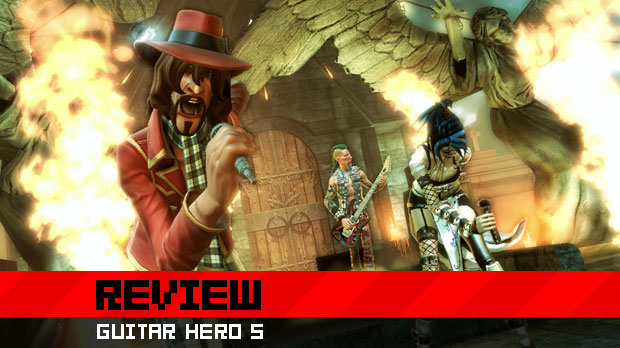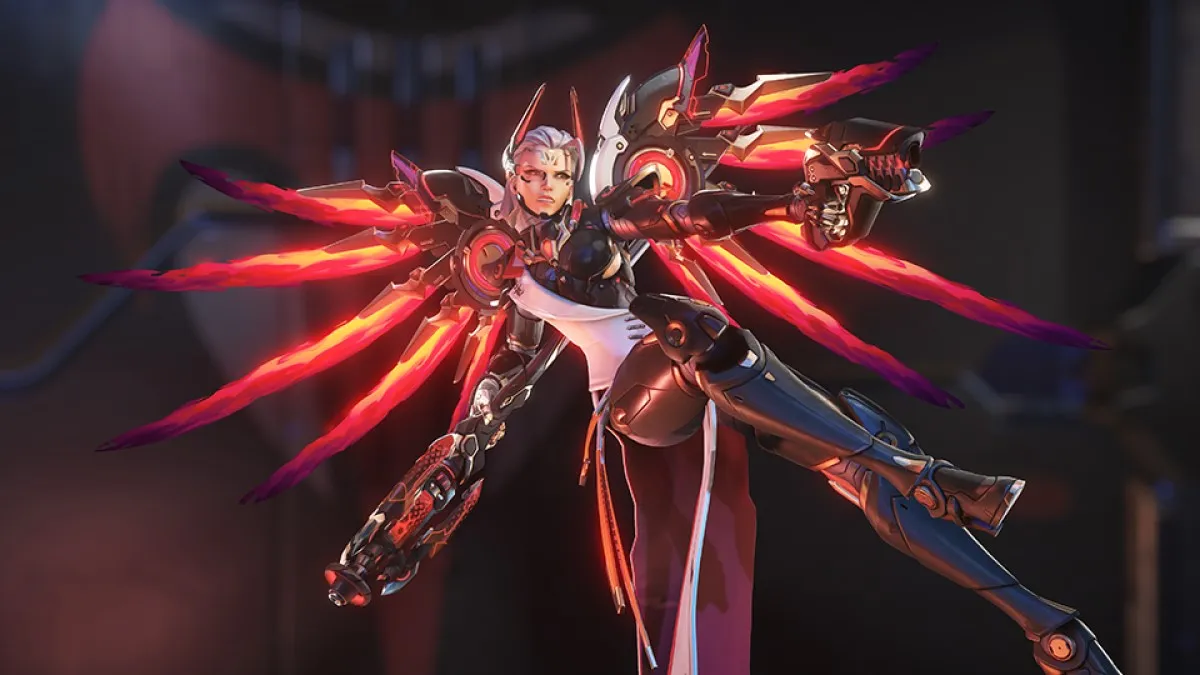While there’s a fat “five” tagged to the name of this game, by no stretch of the imagination is this only the fifth Guitar Hero game to hit the market. Ignoring the mobile and handheld spin-offs, prior to Guitar Hero 5 there have been eight Guitar Hero games on consoles — three developed by Harmonix and four headed by the team at Neversoft.
So I suppose you could consider the latest Guitar Hero to be Neversoft’s fifth, while it’s its third full-band game. At first glance, it would be easy to write it off as more of the same — without a doubt, in many ways it is — but the developer evidently has learned a few lessons, and has made some great strides in design and overall game content. But despite the fact that the title is actually leaps better than its predecessors, it’s not without some glaring issues that could (but probably won’t) ruin the overall experience for some.
More after the jump.
Guitar Hero 5 (Xbox 360, PlayStation 3)
Developer: Neversoft
Publisher: Activision
Released: September 1, 2009
MSRP: $59.99
Among this year’s Guitar Hero 5 “innovations” (that’s the marketing buzz word for “neat new features”) is the ability to play with up to four players using any combination of instruments. These means four drummers or four singers, two guitarists with one singer and a drummer, three bassists and a vocalist… you get the idea. This option is available and open in all modes, and while it doesn’t always make sense in terms of “band play,” it’s a welcome freedom. Four drum sets being pounded on at once? Your neighbors simply won’t know what hit them.

Another novel addition is “Party Play” mode, most easily described as the game’s playable “attract mode.” From the game’s main menu, you can simply hit a button the enter “Party Play.” In this mode, the game will play itself, cycling through the musical tracks available in the game; think of it like a jukebox, if you will. At any point, players can pick up any instrument connected to the console and drop in (or out) at his or her leisure, quickly flipping between difficulties on the fly before joining the game. The music at your party never has to stop, man; difficulty can even be adjusted without a break in the song, a menu popping up for only the player who needs to navigate it.
The Career mode has been tweaked a bit, with a structure that requires you to earn stars to unlock fresh gigs and new venues. By simply playing each song, up to six stars can be earned (for near-perfect performances), but Neversoft also added an additional incentive to replay tracks — “Song Challenges.” Each challenge can earn you up to three additional stars, with one challenge available for each of the songs on the game’s disc. Some challenges require full band play to complete; others are specific to an instrument. (If you’re playing alone on a plastic guitar, the ability to quickly switch between guitar and bass at the press of a button before a song is a nice addition.) The band challenges are entirely optional (although some offer nifty unlockable rewards for completion), and with the exception of a few, none of them seemed unattainable with some skill or practice.
A few changes have been made to the basic band play, as well, most notably the way in which an entire band can fail. Unlike the “one fails, we all fail” nonsense of World Tour, Guitar Hero 5 features a “Band Revival” meter. When one member of the band fails to deliver, their part will drop out. The remaining band members must nail their parts to win over the crowd, the result of which will be allowing the failed player back into the game. This delivers a more cooperative and cohesive band play experience, not one that relies on all members being virtuosos on their instrument of choice.

Unfortunately, the principal problem with band play is that the game’s heads-up display is simply too crowded and far too perplexing. Particularly with the option to play with four note lanes across the screen (one per instrument), things get out of hand. Your eyes have to dart all over the screen to keep up with things like how much Star Power you have, your multiplier, or even how well you’re doing. There’s just too much information on the screen in too many places. It’s all a bit exhausting (and irritating) to keep up with, and while it doesn’t completely ruin the experience, it’s certainly not ideal.
On the competitive side of things, Guitar Hero 5 really delivers with six different multiplayer modes available at your disposal, including some for up to four players. One example, “Momentum,” is particularly fun — song charts get more difficult the better you do, or easier if you’re dropping the ball. When it comes to competitive play, Guitar Hero 5 is king — Neversoft obviously focused on fun and varied multiplayer choices, and they succeed quite well.
As for the game’s on-disc music selection, Guitar Hero 5 brings less filler than World Tour, with 85 songs from artists you either like or (at the very least) have heard of. The set list also features more diversity than previous games, branching out and away from typical “rock” and venturing into other territory like funk. The good news is that all of the songs are unlocked immediately, allowing you to hop in to “Party Play” or one-off games immediately — there’s no need to fight through the game’s career mode to get to your favorite song.
As far as how the songs play, it’s a mixed and sometimes frustrating bag. The problem isn’t so much the charting of the individual instruments — most parts feel and “play” like their real life counterparts, although the vocal difficulty seems a bit off-the-wall. (We had Shirley Manson* come by to sing “Only Happy When It Rains” on Medium and she got an 89%, for instance.) The issue is more what parts Neversoft chose to chart for many of the songs.
* Not the real Shirley Manson, but it was a red-headed Scottish woman.

Take Stevie Wonder’s “Superstition” for instance, a classic and brilliant track. The main iconic synth riff is not actually a… you know… guitar. However, the nature of the riff does lend itself to the instrument, and it’s fun and natural to play in Guitar Hero 5 (or on a real guitar; give it a try!). The problem comes into play when parts of the game decide that you’re no longer playing a guitar or a keyboard, but suddenly and without warning, you’re the song’s brass section. On your plastic guitar. Not only does it not feel natural or expected, but it’s confusing and off-putting. Another instance, and possibly a worse offender, is the Rolling Stones’ “Sympathy for the Devil.” Problem — it’s mostly piano, so playing it on a plastic guitar doesn’t feel right and, more importantly, isn’t particularly fun.
“GH Tunes” is back, and the good news is that it’s been streamlined, making it easier to hop in and start creating a song with little effort. While the full-featured tool that was introduced in World Tour was cluttered and clumsy, GH Tunes 2.0 is more intuitive from the get-go. But despite the new editing tools and new guitar samples, everything still ends up sounding like cheap MIDI, or a free ring tone you might have gotten with your new cell service back in 1998. Neversoft is to be applauded for offering up tools that allow players to express their creativity in a game genre that some people feel threatens that very thing. Unfortunately, anyone with true musical aspirations will likely be underwhelmed by the results, and gamers will likely tire of the strange, user-created content quickly.
Visually, Guitar Hero 5 is actually a pretty big leap for the series if you know what to look for. The bright, over-the-top style of the franchise has fortunately been toned down a bit. The game’s normally stark colors have been muted a bit — including the notes on the highway — which may come as an initial shock to veterans, but your eyes will quickly adjust.

Other good news is that the game’s animations have been improved along with the general look of the on-screen avatars. Things are still larger than life — stage shows featuring fireworks and dragons, for instance — but it no longer looks like you’re watching the music video for Genesis’ “Land of Confusion.” Neversoft has tweaked the camera angles for a more cinematic rock concert experience, which (for what may be a first for the series since its inception) is actually fun to watch.
Overall, Guitar Hero 5 is an improved experience this year, without a doubt the best of Activision’s full-band games to date. There’s enough here to satisfy fans of plastic instruments, and if you’ve got four drum sets, this is the only place you’ll get to use them all at the same time. Despite its marked improvements, those who have have pledged their allegiance to other music titles likely won’t be swayed, but that doesn’t mean Guitar Hero 5 isn’t worth your time.
Score: 8.0 — Great (8s are impressive efforts with a few noticeable problems holding them back. Won’t astound everyone, but is worth your time and cash.)














Published: Sep 1, 2009 08:00 pm